Photo-Induced Preparation of Ag@MOF-801 Composite Based Heterogeneous Nanocatalyst for the Production of Biodiesel
Abstract
:1. Introduction
2. Results and Discussions
2.1. X-ray Powder Diffraction (XRD) Analysis
2.2. SEM and EDX Analysis of Ag@MOF-801
2.3. UV-Visible and Fourier-Transform Infrared Spectroscopy Analysis
2.4. Catalytic Evaluation of Ag@MOF-801
2.5. Mechanism of Biodiesel Production Using Ag@MOF-801
3. Materials and Methods
3.1. Materials
3.2. Sample Preparation (Ag@MOF-801)
3.3. Transesterification of Used Vegetables Oil (UVO) Using Ag@MOF-801
3.4. Characterization
4. Conclusions
Supplementary Materials
Author Contributions
Funding
Data Availability Statement
Acknowledgments
Conflicts of Interest
References
- Stock, N.; Biswas, S. Synthesis of metal-organic frameworks (MOFs): Routes to various MOF topologies, morphologies, and composites. Chem. Rev. 2012, 112, 933–969. [Google Scholar] [CrossRef] [PubMed]
- Zhou, H.-C.; Long, J.R.; Yaghi, O.M. Introduction to metal–organic frameworks. Chem. Rev. 2012, 112, 673–674. [Google Scholar] [CrossRef] [PubMed]
- Chen, L.; Zhang, X.; Cheng, X.; Xie, Z.; Kuang, Q.; Zheng, L. The function of metal–organic frameworks in the application of MOF-based composites. Nanoscale Adv. 2020, 2, 2628–2647. [Google Scholar] [CrossRef]
- Lian, X.; Fang, Y.; Joseph, E.; Wang, Q.; Li, J.; Banerjee, S.; Lollar, C.; Wang, X.; Zhou, H.-C. Enzyme–MOF (metal–organic framework) composites. Chem. Soc. Rev. 2017, 46, 3386–3401. [Google Scholar] [CrossRef]
- Chen, J.; Zhu, Y.; Kaskel, S. Porphyrin-Based Metal-Organic Frameworks for Biomedical Applications. Angew. Chem. Int. Ed. 2021, 60, 5010–5035. [Google Scholar] [CrossRef] [Green Version]
- Mandal, S.; Natarajan, S.; Mani, P.; Pankajakshan, A. Post-Synthetic Modification of Metal-Organic Frameworks Toward Applications. Adv. Funct. Mater. 2021, 31, 2006291. [Google Scholar] [CrossRef]
- Liu, M.; Liang, J.; Tian, Y.; Liu, Z. Post-synthetic modification within MOFs: A valuable strategy for modulating their ferroelectric performance. CrystEngComm 2022, 24, 724–737. [Google Scholar] [CrossRef]
- Wang, Q.; Astruc, D. State of the art and prospects in metal–organic framework (MOF)-based and MOF-derived nanocatalysis. Chem. Rev. 2019, 120, 1438–1511. [Google Scholar] [CrossRef]
- Khan, M.; Tahir, M.N.; Adil, S.F.; Khan, H.U.; Siddiqui, M.R.H.; Al-warthan, A.A.; Tremel, W. Graphene based metal and metal oxide nanocomposites: Synthesis, properties and their applications. J. Mater. Chem. A 2015, 3, 18753–18808. [Google Scholar] [CrossRef] [Green Version]
- Yu, J.; Mu, C.; Yan, B.; Qin, X.; Shen, C.; Xue, H.; Pang, H. Nanoparticle/MOF composites: Preparations and applications. Mater. Horiz. 2017, 4, 557–569. [Google Scholar] [CrossRef]
- Song, Z.; Zhang, L.; Doyle-Davis, K.; Fu, X.; Luo, J.L.; Sun, X. Recent advances in MOF-derived single atom catalysts for electrochemical applications. Adv. Energy Mater. 2020, 10, 2001561. [Google Scholar] [CrossRef]
- Manna, K.; Zhang, T.; Lin, W. Postsynthetic metalation of bipyridyl-containing metal–organic frameworks for highly efficient catalytic organic transformations. J. Am. Chem. Soc. 2014, 136, 6566–6569. [Google Scholar] [CrossRef] [PubMed]
- Yuan, S.; Chen, Y.P.; Qin, J.; Lu, W.; Wang, X.; Zhang, Q.; Bosch, M.; Liu, T.F.; Lian, X.; Zhou, H.C. Cooperative cluster metalation and ligand migration in zirconium metal–organic frameworks. Angew. Chem. Int. Ed. 2015, 54, 14696–14700. [Google Scholar] [CrossRef] [PubMed]
- Lang, X.; Wang, X.; Liu, Y.; Cai, K.; Li, L.; Zhang, Q. Cobalt-based metal organic framework (Co-MOFs)/graphene oxide composites as high-performance anode active materials for lithium-ion batteries. Int. J. Energy Res. 2021, 45, 4811–4820. [Google Scholar] [CrossRef]
- Subudhi, S.; Tripathy, S.P.; Parida, K. Metal oxide integrated metal organic frameworks (MO@MOF): Rational design, fabrication strategy, characterization and emerging photocatalytic applications. Inorg. Chem. Front. 2021, 8, 1619–1636. [Google Scholar] [CrossRef]
- Buasakun, J.; Srilaoong, P.; Rattanakam, R.; Duangthongyou, T. Synthesis of Heterostructure of ZnO@MOF-46 (Zn) to Improve the Photocatalytic Performance in Methylene Blue Degradation. Crystals 2021, 11, 1379. [Google Scholar] [CrossRef]
- Jiang, D.; Wei, C.; Zhu, Z.; Xu, X.; Lu, M.; Wang, G. Preparation of Flower-Like Nickel-Based Bimetallic Organic Framework Electrodes for High-Efficiency Hybrid Supercapacitors. Crystals 2021, 11, 1425. [Google Scholar] [CrossRef]
- Zhu, K.; Chen, C.; Lu, S.; Zhang, X.; Alsaedi, A.; Hayat, T. MOFs-induced encapsulation of ultrafine Ni nanoparticles into 3D N-doped graphene-CNT frameworks as a recyclable catalyst for Cr(VI) reduction with formic acid. Carbon 2019, 148, 52–63. [Google Scholar] [CrossRef]
- Karve, V.V.; Sun, D.T.; Trukhina, O.; Yang, S.; Oveisi, E.; Luterbacher, J.; Queen, W.L. Efficient reductive amination of HMF with well dispersed Pd nanoparticles immobilized in a porous MOF/polymer composite. Green Chem. 2020, 22, 368–378. [Google Scholar] [CrossRef]
- Zhang, W.; Lu, G.; Cui, C.; Liu, Y.; Li, S.; Yan, W.; Xing, C.; Chi, Y.R.; Yang, Y.; Huo, F. A family of metal-organic frameworks exhibiting size-selective catalysis with encapsulated noble-metal nanoparticles. Adv. Mater. 2014, 26, 4056–4060. [Google Scholar] [CrossRef]
- Dhakshinamoorthy, A.; Garcia, H. Catalysis by metal nanoparticles embedded on metal–organic frameworks. Chem. Soc. Rev. 2012, 41, 5262–5284. [Google Scholar] [CrossRef] [PubMed]
- Rivera-Torrente, M.; Filez, M.; Hardian, R.; Reynolds, E.; Seoane, B.; Coulet, M.V.; Oropeza Palacio, F.E.; Hofmann, J.P.; Fischer, R.A.; Goodwin, A.L.; et al. Metal-Organic Frameworks as Catalyst Supports: Influence of Lattice Disorder on Metal Nanoparticle Formation. Chem. Eur. J. 2018, 24, 7498–7506. [Google Scholar] [CrossRef] [PubMed]
- Moon, H.R.; Lim, D.-W.; Suh, M.P. Fabrication of metal nanoparticles in metal–organic frameworks. Chem. Soc. Rev. 2013, 42, 1807–1824. [Google Scholar] [CrossRef] [PubMed]
- Yu, X.; Wang, L.; Cohen, S.M. Photocatalytic metal–organic frameworks for organic transformations. CrystEngComm 2017, 19, 4126–4136. [Google Scholar] [CrossRef]
- Li, B.; Ma, J.G.; Cheng, P. Integration of metal nanoparticles into metal–organic frameworks for composite catalysts: Design and synthetic strategy. Small 2019, 15, 1804849. [Google Scholar] [CrossRef]
- Singh, B.K.; Lee, S.; Na, K. An overview on metal-related catalysts: Metal oxides, nanoporous metals and supported metal nanoparticles on metal organic frameworks and zeolites. Rare Met. 2020, 39, 751–766. [Google Scholar] [CrossRef]
- Lo, W.-S.; Chou, L.-Y.; Young, A.P.; Ren, C.; Goh, T.W.; Williams, B.P.; Li, Y.; Chen, S.-Y.; Ismail, M.N.; Huang, W.; et al. Probing the Interface between Encapsulated Nanoparticles and Metal–Organic Frameworks for Catalytic Selectivity Control. Chem. Mater. 2021, 33, 1946–1953. [Google Scholar] [CrossRef]
- Wang, D.; Song, Y.; Cai, J.; Wu, L.; Li, Z. Effective photo-reduction to deposit Pt nanoparticles on MIL-100 (Fe) for visible-light-induced hydrogen evolution. New J. Chem. 2016, 40, 9170–9175. [Google Scholar] [CrossRef]
- Doherty, C.M.; Buso, D.; Hill, A.J.; Furukawa, S.; Kitagawa, S.; Falcaro, P. Using functional nano-and microparticles for the preparation of metal–organic framework composites with novel properties. Acc. Chem. Res. 2014, 47, 396–405. [Google Scholar] [CrossRef]
- Wang, Z.; Zhao, S.; Zhu, S.; Sun, Y.; Fang, M. Photocatalytic synthesis of M/Cu2O (M = Ag, Au) heterogeneous nanocrystals and their photocatalytic properties. CrystEngComm 2011, 13, 2262–2267. [Google Scholar] [CrossRef]
- Lu, Q.; Zhu, L.; Han, S.; Hou, Y.; Cao, W. Photocatalytic synthesis of gold nanoparticles using TiO2 nanorods: A mechanistic investigation. Phys. Chem. Chem. Phys. 2019, 21, 18753–18757. [Google Scholar] [CrossRef] [PubMed]
- Sun, D.; Liu, W.; Fu, Y.; Fang, Z.; Sun, F.; Fu, X.; Zhang, Y.; Li, Z. Noble metals can have different effects on photocatalysis over metal–organic frameworks (MOFs): A case study on M/NH2-MIL-125 (Ti)(M = Pt and Au). Chem. Eur. J. 2014, 20, 4780–4788. [Google Scholar] [CrossRef] [PubMed]
- Guo, J.; Wan, Y.; Zhu, Y.; Zhao, M.; Tang, Z. Advanced photocatalysts based on metal nanoparticle/metal-organic framework composites. Nano Res. 2021, 14, 2037–2052. [Google Scholar] [CrossRef]
- Sun, D.; Li, Z. Robust Ti- and Zr-based metal-organic frameworks for photocatalysis. Chin. J. Chem. 2017, 35, 135–147. [Google Scholar] [CrossRef]
- Shaik, M.R.; Adil, S.F.; ALOthman, Z.A.; Alduhaish, O.M. Fumarate Based Metal–Organic Framework: An Effective Catalyst for the Transesterification of Used Vegetable Oil. Crystals 2022, 12, 151. [Google Scholar] [CrossRef]
- Al-Marri, A.H.; Khan, M.; Khan, M.; Adil, S.F.; Al-Warthan, A.; Alkhathlan, H.Z.; Tremel, W.; Labis, J.P.; Siddiqui, M.R.H.; Tahir, M.N. Pulicaria glutinosa extract: A toolbox to synthesize highly reduced graphene oxide-silver nanocomposites. Int. J. Mol. Sci. 2015, 16, 1131–1142. [Google Scholar] [CrossRef] [Green Version]
- Kim, B.; Im, H.; Lee, J.W. In situ transesterification of highly wet microalgae using hydrochloric acid. Bioresour. Technol. 2015, 185, 421–425. [Google Scholar] [CrossRef]
- Ma, X.; Liu, F.; Helian, Y.; Li, C.; Wu, Z.; Li, H.; Chu, H.; Wang, Y.; Wang, Y.; Lu, W. Current application of MOFs based heterogeneous catalysts in catalyzing transesterification/esterification for biodiesel production: A review. Energy Convers. Manage. 2021, 229, 113760. [Google Scholar] [CrossRef]
- Cong, W.-J.; Nanda, S.; Li, H.; Fang, Z.; Dalai, A.K.; Kozinski, J.A. Metal–organic framework-based functional catalytic materials for biodiesel production: A review. Green Chem. 2021, 23, 2595–2618. [Google Scholar] [CrossRef]
- Cirujano, F.; Corma, A.; i Xamena, F.L. Zirconium-containing metal organic frameworks as solid acid catalysts for the esterification of free fatty acids: Synthesis of biodiesel and other compounds of interest. Catal. Today 2015, 257, 213–220. [Google Scholar] [CrossRef]
- Xie, W.; Wan, F. Guanidine post-functionalized crystalline ZIF-90 frameworks as a promising recyclable catalyst for the production of biodiesel via soybean oil transesterification. Energy Convers. Manag. 2019, 198, 111922. [Google Scholar] [CrossRef]
- Pangestu, T.; Kurniawan, Y.; Soetaredjo, F.E.; Santoso, S.P.; Irawaty, W.; Yuliana, M.; Hartono, S.B.; Ismadji, S. The synthesis of biodiesel using copper based metal-organic framework as a catalyst. J. Environ. Chem. Eng. 2019, 7, 103277. [Google Scholar] [CrossRef] [Green Version]
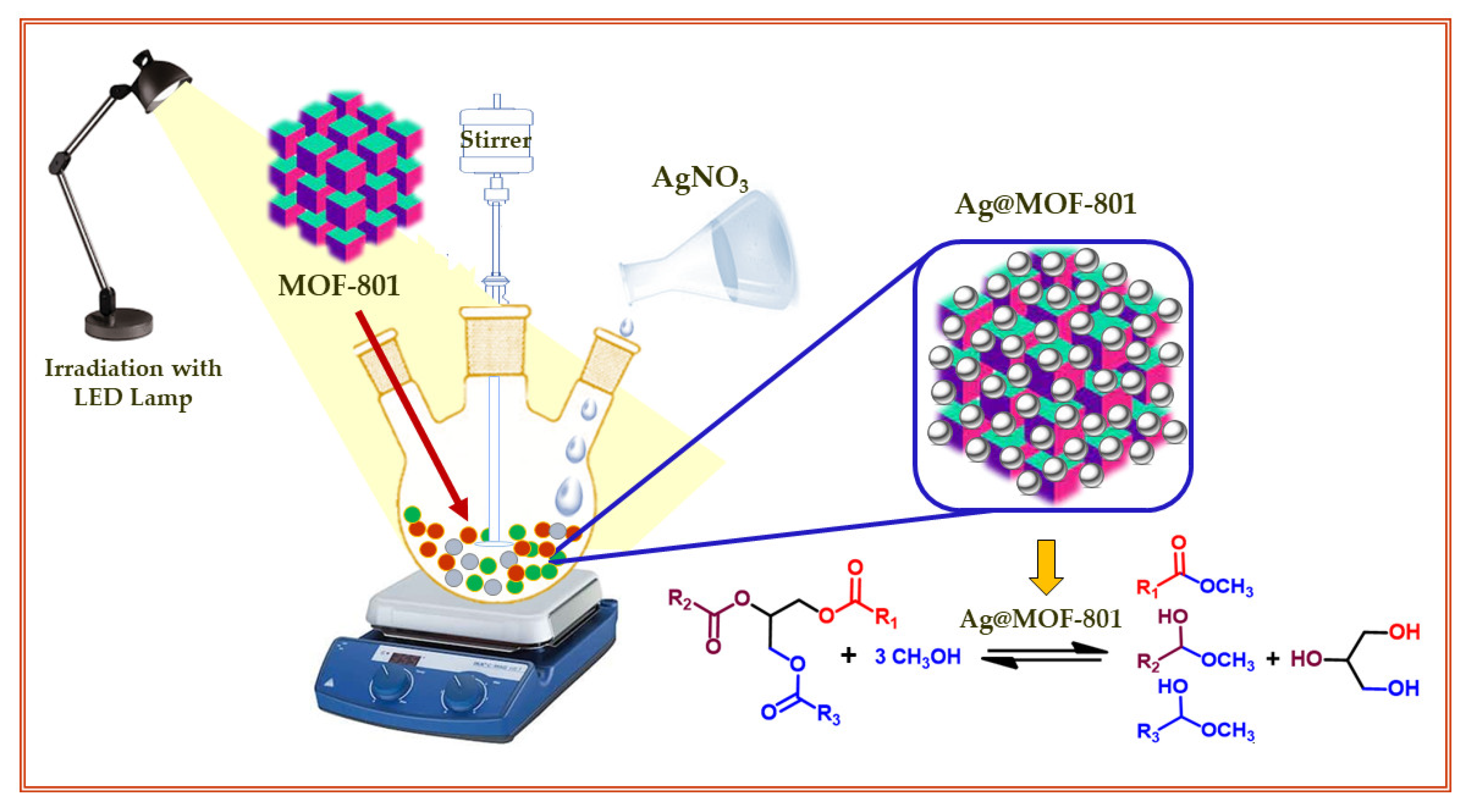
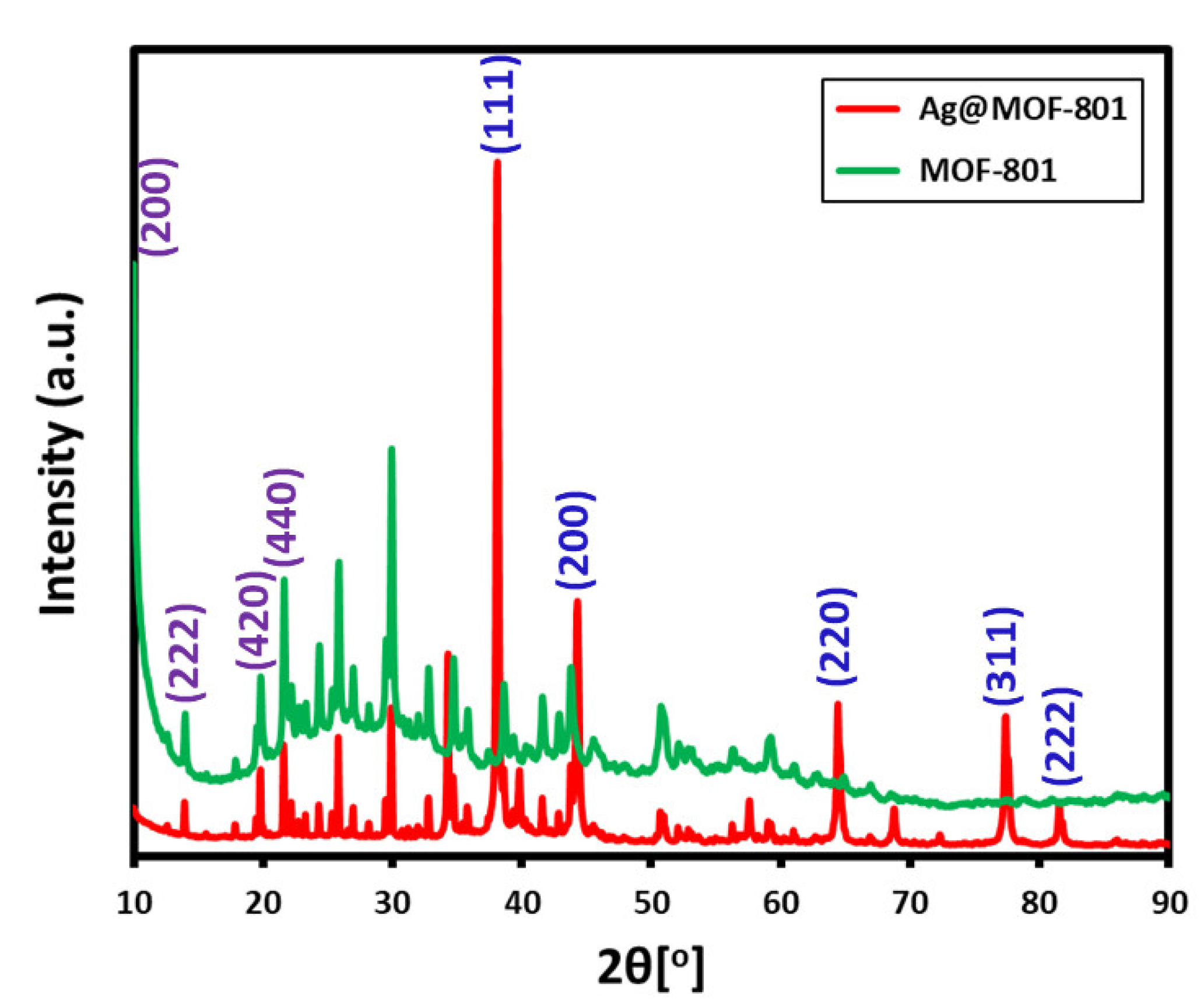
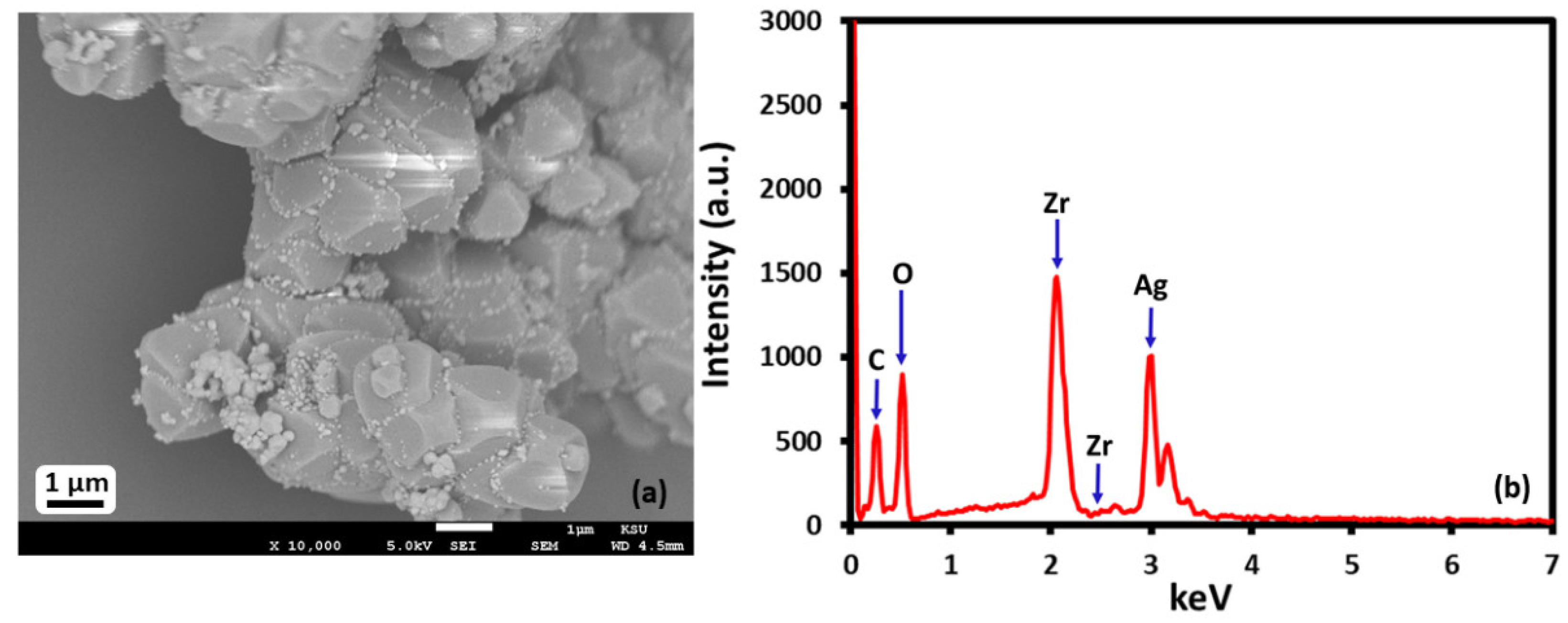
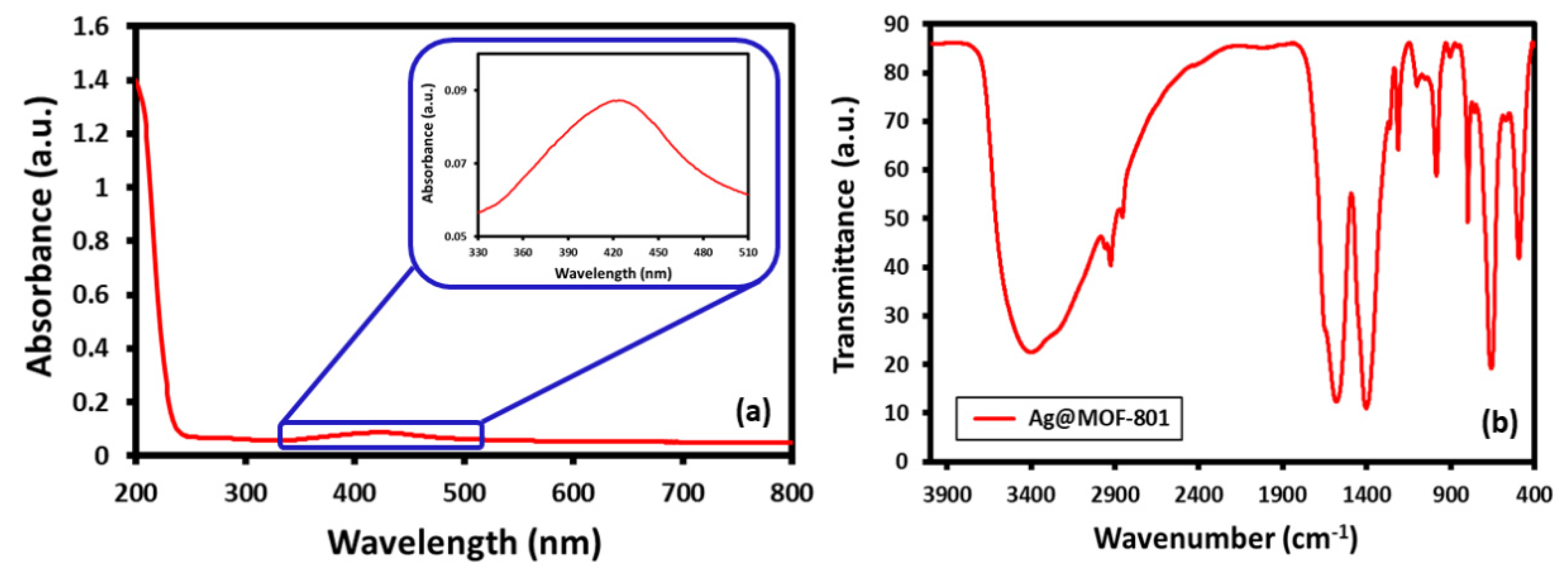
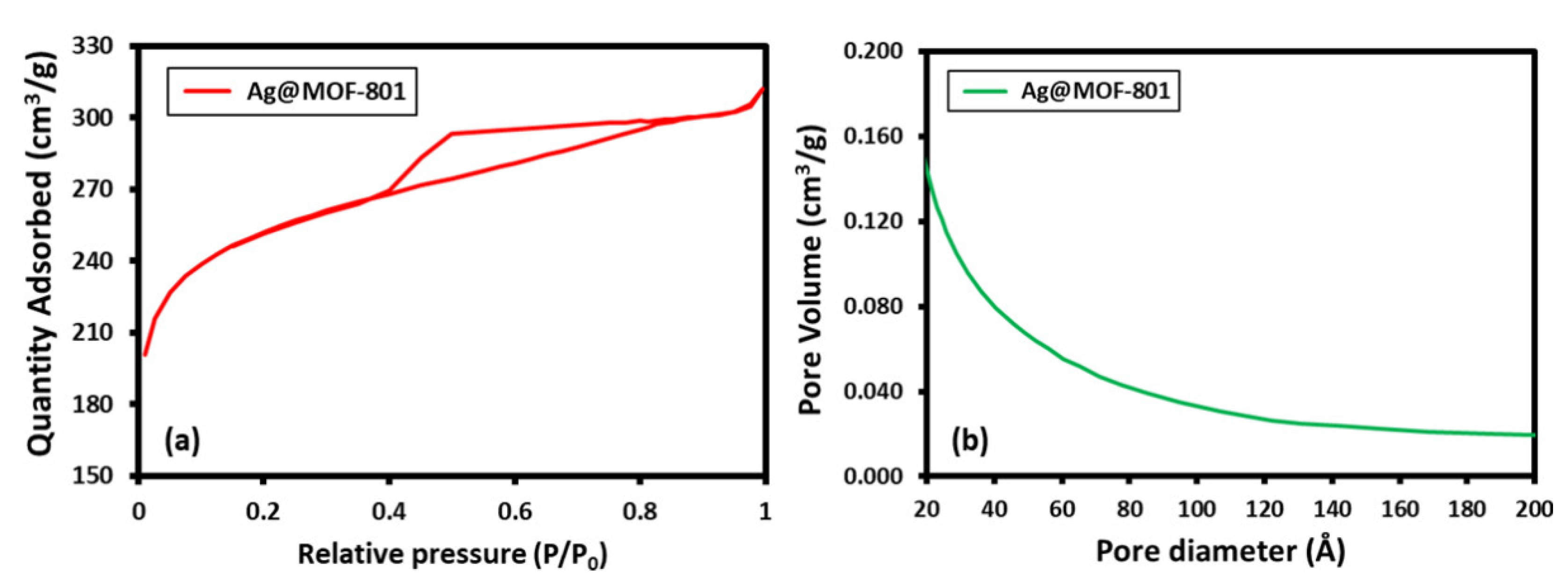
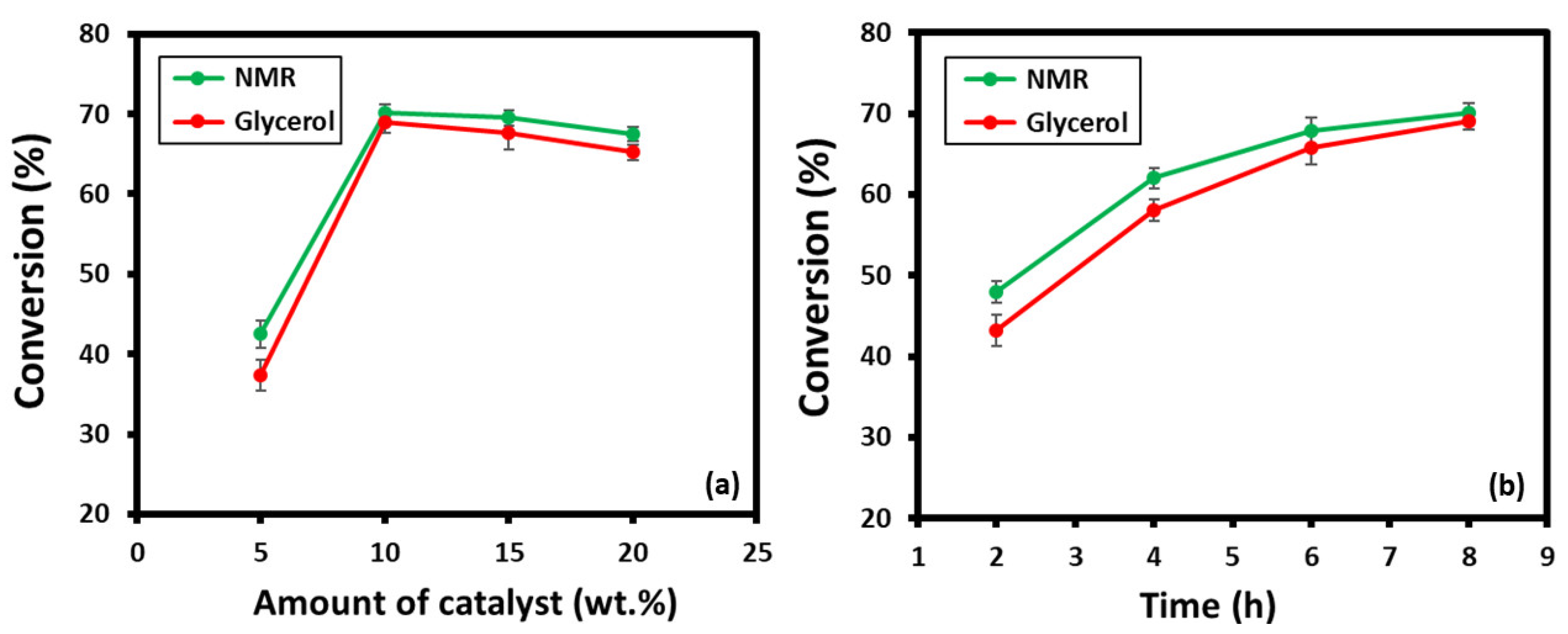
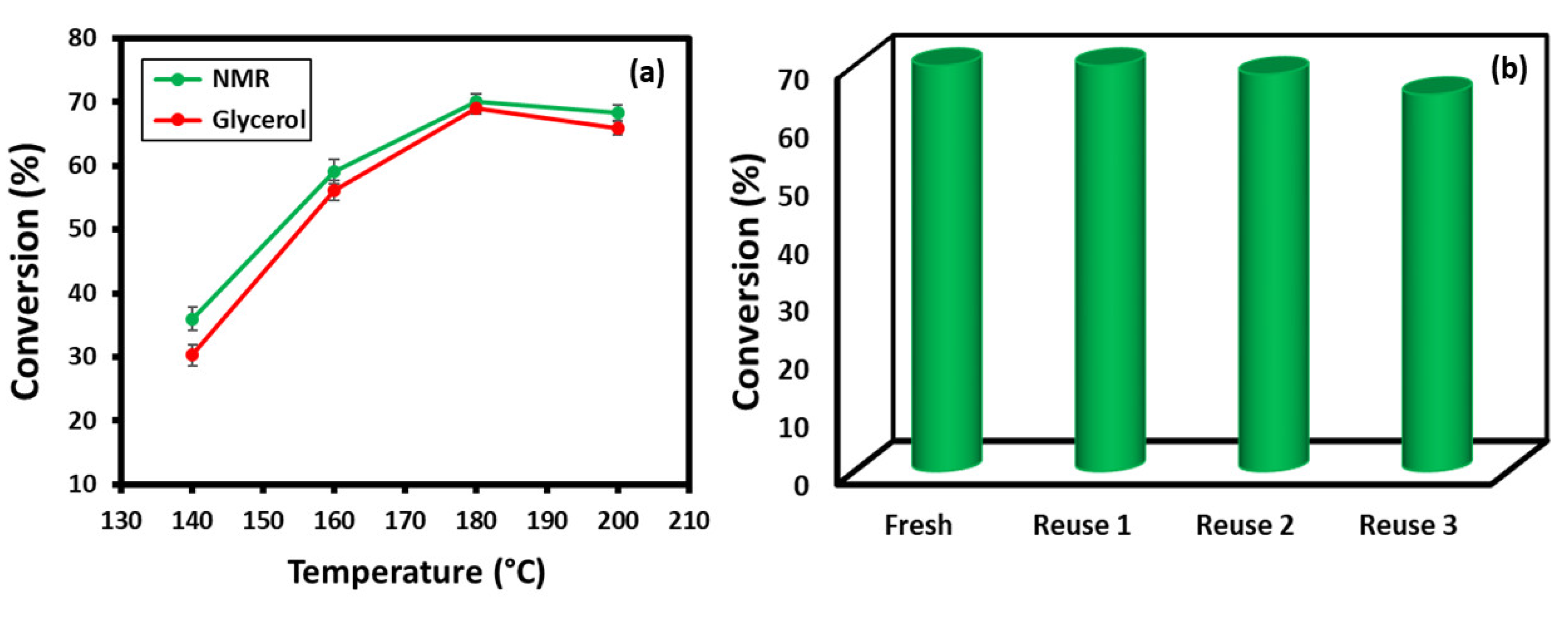

| Catalyst | Oil (g) | Amount of Catalyst | Product Yield (g) | Conversion (%) | |||
|---|---|---|---|---|---|---|---|
| Wt. % to Oil | Amount (g) | Biodiesel | Glycerol | 1H-NMR | Yield of Glycerol | ||
| Ag@MOF-801 | 1.5 | 5 | 0.075 | 1.334 | 0.058 | 42.5 | 37.4 |
| Ag@MOF-801 | 10 | 0.150 | 1.423 | 0.107 | 70.1 | 69.0 | |
| Ag@MOF-801 | 15 | 0.225 | 1.419 | 0.105 | 69.5 | 67.7 | |
| Ag@MOF-801 | 20 | 0.300 | 1.416 | 0.101 | 67.5 | 65.2 | |
| Ag@MOF-801/HCl | 10 | 0.150 | 1.491 | 0.124 | 73.1 | 72.9 | |
Publisher’s Note: MDPI stays neutral with regard to jurisdictional claims in published maps and institutional affiliations. |
© 2022 by the authors. Licensee MDPI, Basel, Switzerland. This article is an open access article distributed under the terms and conditions of the Creative Commons Attribution (CC BY) license (https://creativecommons.org/licenses/by/4.0/).
Share and Cite
Alduhaish, O.M.; Shaik, M.R.; Adil, S.F. Photo-Induced Preparation of Ag@MOF-801 Composite Based Heterogeneous Nanocatalyst for the Production of Biodiesel. Catalysts 2022, 12, 533. https://doi.org/10.3390/catal12050533
Alduhaish OM, Shaik MR, Adil SF. Photo-Induced Preparation of Ag@MOF-801 Composite Based Heterogeneous Nanocatalyst for the Production of Biodiesel. Catalysts. 2022; 12(5):533. https://doi.org/10.3390/catal12050533
Chicago/Turabian StyleAlduhaish, Osamah M., Mohammed Rafi Shaik, and Syed Farooq Adil. 2022. "Photo-Induced Preparation of Ag@MOF-801 Composite Based Heterogeneous Nanocatalyst for the Production of Biodiesel" Catalysts 12, no. 5: 533. https://doi.org/10.3390/catal12050533
APA StyleAlduhaish, O. M., Shaik, M. R., & Adil, S. F. (2022). Photo-Induced Preparation of Ag@MOF-801 Composite Based Heterogeneous Nanocatalyst for the Production of Biodiesel. Catalysts, 12(5), 533. https://doi.org/10.3390/catal12050533








